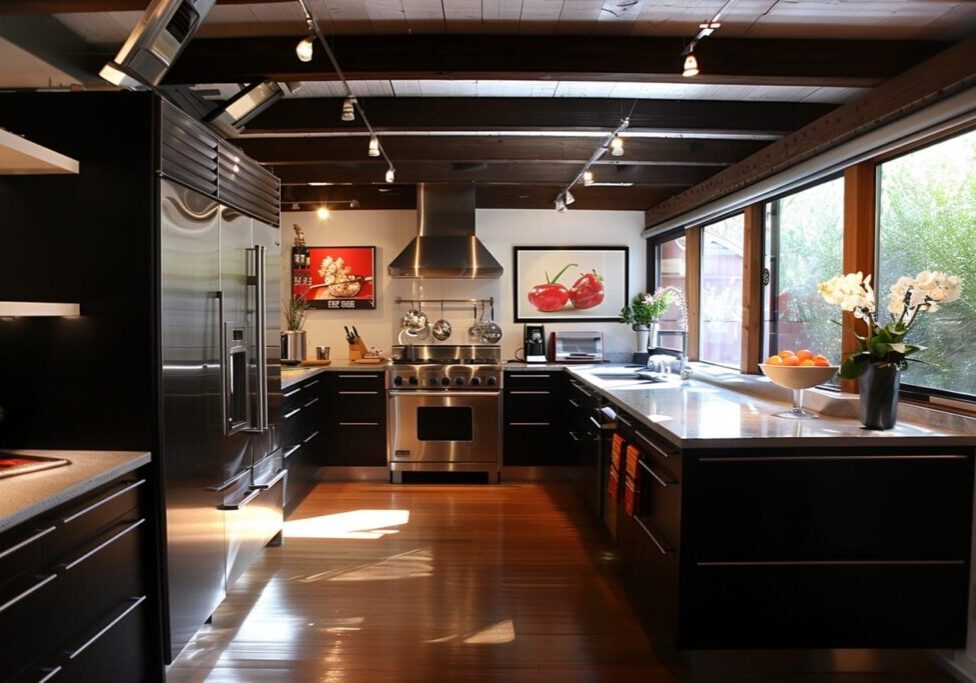The Role of the Kitchen Triangle in Modern Designs

In the world of kitchen design, the concept of the “kitchen triangle,” also known as the “work triangle,” remains a cornerstone of efficiency. Originally devised in the early 20th century, this layout theory was intended to streamline the primary tasks in the kitchen by arranging the three most-used work sites—the sink, the stove, and the refrigerator—at optimal distances from one another. By forming an imaginary triangle between these points, the kitchen’s functionality is maximized, allowing cooks to move swiftly and efficiently between tasks.
Components of the Kitchen Triangle
- The Sink: Often the hub of kitchen activity, the sink is where most of the cleaning and preparation happens. It’s where vegetables are washed, hands are rinsed, and dishes are cleaned, making it a critical point in the kitchen triangle.
- The Stove: As the cooking site, the stove is where food is heated and cooked. Its placement in relation to the sink and refrigerator affects meal preparation efficiency, as it often requires quick transitions between these points.
- The Refrigerator: The primary storage area for perishable goods, the refrigerator must be conveniently located to both the sink and stove, allowing for easy access to ingredients and efficient meal prep and cleanup.
Relevance in Modern Kitchen Designs
The kitchen triangle’s fundamental goal is to reduce unnecessary movement, making the kitchen a more efficient and safer space. Modern kitchen designs often still adhere to this tried-and-true principle, even as kitchens themselves evolve with changes in lifestyle, technology, and aesthetics. Today, designers might adapt the traditional triangle to accommodate multiple cooks, incorporate kitchen islands, or expand it into larger open-plan spaces that integrate dining and living areas. Despite these changes, the kitchen triangle continues to influence designs, ensuring that the kitchen remains as functional as it is beautiful.
History of the Kitchen Triangle
The kitchen triangle, a model that has shaped the ergonomics of kitchen design for decades, originated in the early 20th century as a product of systematic home management and architectural innovation. The idea was formulated during a period of significant change in the domestic landscape, with the aim of simplifying kitchen tasks and reducing the physical strain associated with cooking.
Origins of the Kitchen Triangle Concept
The concept of the kitchen triangle was first introduced by the University of Illinois School of Architecture in the 1940s. Researchers at the university conducted time-motion studies to determine the most efficient paths between the three primary kitchen workstations: the sink, the stove, and the refrigerator. Their findings led to the formulation of the kitchen work triangle theory, which posits that these key areas should be neither too close nor too far from one another. Typically, the sum of the distances between them should be no less than 10 feet and no more than 25 feet. This layout was designed to minimize unnecessary steps and facilitate easier movement within the kitchen.
Development to Improve Kitchen Efficiency
The introduction of the kitchen triangle was a response to the inefficiencies observed in many residential kitchens of the time. Prior to its development, kitchens were often cluttered and disorganized, with major appliances and workstations spread haphazardly throughout the space. This often resulted in a kitchen that was tiring to operate and prone to accidents. The kitchen triangle brought a sense of order and structure, defining clear pathways and optimizing space usage, which in turn improved the overall flow and functionality of the kitchen environment.
Evolution of Kitchen Layouts from Past to Present
Over the decades, the kitchen triangle has evolved to accommodate changing lifestyles, advancements in technology, and shifts in design aesthetics. In the mid-20th century, the model was largely applied to smaller, more compact kitchens typical of the post-war era. As homes grew larger and open-plan designs became more popular, the kitchen triangle adapted to these new spaces, expanding and sometimes integrating additional elements like kitchen islands, which themselves often contain one or more points of the triangle.
Modern kitchen designs continue to be influenced by the principles of the kitchen triangle, albeit in a more flexible format. Designers now consider the needs of multiple cooks, the integration of smart appliances, and the overall integration of the kitchen with other living spaces. This has led to more dynamic and adaptable kitchen layouts, where the principles of the kitchen triangle are balanced with the desire for aesthetic appeal and communal living.
Adapting the Kitchen Triangle to Contemporary Needs
As society evolves, so do the designs and functionalities of our living spaces, particularly the kitchen. The traditional kitchen triangle, while still a cornerstone of design, has been adapted to meet the more complex needs of modern households. These adaptations address changes in family structures, the increasing popularity of kitchen islands, and the introduction of modern appliances.
Changes in Family Structures and Kitchen Use
Modern families often feature dual-income parents, a greater emphasis on communal activities, and children participating in meal preparation. These changes necessitate a kitchen that supports multiple cooks and areas for social interaction, necessitating adjustments to the traditional kitchen triangle. To accommodate this, designers now often consider multiple work zones or expanded triangles that include additional counterspace for kids to do homework or guests to socialize without disrupting the cooking area.
Incorporation of Kitchen Islands
Kitchen islands have become a central feature in modern kitchens, both as a response to the need for more versatile spaces and as a way to enhance the traditional work triangle. An island can serve various functions: as a prep station, additional storage, or an informal dining area. When integrated into the kitchen layout, an island often houses one or more components of the traditional triangle. For example, an island might include a prep sink or a cooktop, effectively modifying the traditional paths between the sink, stove, and refrigerator. This adaptation allows for a more flexible movement pattern and supports the interaction between multiple users in the kitchen.
Modern Appliances and Their Placement
The placement of modern appliances is also crucial in adapting the kitchen triangle to contemporary needs. Advances in technology have introduced a range of high-tech appliances that can influence kitchen layout. For example, modern refrigerators with features like in-door ice dispensers or touchscreen interfaces may be placed strategically to enhance accessibility and minimize congestion. Similarly, advanced cooktops and ovens with features like smart temperature control, induction cooking surfaces, or double ovens might be installed in an island or on a particular side of the kitchen to optimize the workflow and integrate seamlessly with the rest of the triangle.
Smart dishwashers and other automated appliances are often placed where they can be easily loaded from the main prep area yet remain accessible for unloading near storage spaces. This careful placement ensures that while the core principles of the kitchen triangle are maintained, they are also enhanced to support the efficiency and functionality demanded by modern life.
Design Tips for Implementing the Kitchen Triangle
Implementing the kitchen triangle effectively requires careful planning and thoughtful consideration of how each component—sink, stove, and refrigerator—will function within the space. Here are some design tips on how to measure, plan, and optimize each point of the triangle, especially in smaller kitchens.
Measuring and Planning for an Effective Kitchen Triangle
- Assess Your Space: Begin by measuring the total area of your kitchen to understand the feasible layout options. This assessment will help you determine the best placement for the triangle’s points.
- Distance Between Components: Ensure the distance between each component of the triangle (sink, stove, refrigerator) is neither too short nor too long. Ideally, each leg of the triangle should be between 4 and 9 feet. The total perimeter of the triangle should not exceed 26 feet to maintain efficiency and comfort in movement.
- Minimal Obstructions: Plan the layout to ensure that the paths between the triangle’s points are clear of obstacles like islands, tables, or bins that could impede movement.
- Visualization Tools: Use kitchen design software or simple graph paper to visualize and plan the placement of each component. This planning will help you see potential flow issues before they become problems.
Optimizing Each Point of the Triangle
- Sink: Position the sink between or adjacent to the cooking and refrigeration zones, as it sees the most activity. Ensure there is ample counter space on both sides of the sink for washing and preparing food.
- Stove: Place the stove in a location that minimizes traffic from non-cooking activities to ensure safety and efficiency. Consider ventilation when positioning your stove—ideally, it should have a range hood directly above it.
- Refrigerator: The refrigerator should be accessible to both the sink and cooking areas but positioned to avoid congestion. Ensure that its door can open fully without blocking pathways or hitting other appliances.
Considerations for Small Kitchens
- Scale Down: In smaller kitchens, it’s crucial to scale down appliances to fit the space without sacrificing functionality. Consider compact or under-counter appliances to save space.
- Innovative Solutions: If the traditional triangle is not feasible, think creatively about how to arrange your space. For instance, consider using a galley layout with the sink and stove on one side and the refrigerator on the opposite side.
- Vertical Storage: Utilize vertical space for storage to free up as much floor area as possible, which helps in maintaining a clear path within the triangle.
- Multipurpose Elements: Incorporate multipurpose elements, such as a movable island that can be used as both a prep area and additional storage. This flexibility can be especially valuable in adapting the kitchen triangle to a small space.
By following these design tips and considering the specific challenges and opportunities of your kitchen space, you can effectively implement the kitchen triangle to enhance both the functionality and enjoyment of your cooking environment. Whether your kitchen is spacious or compact, these strategies will help create a well-organized and efficient layout.
Challenges and Modifications
While the kitchen triangle has stood the test of time as a fundamental design principle for efficient kitchen layouts, it faces certain challenges and limitations in ultra-modern designs. Moreover, the advent of new technologies and kitchen tools also plays a significant role in how contemporary kitchens are planned. This section explores these challenges, examines alternative layout theories, and discusses the impact of modern technologies.
Potential Limitations in Ultra-Modern Designs
Ultra-modern kitchen designs often emphasize minimalist aesthetics, open-plan living, and multi-functional spaces, which can challenge the traditional kitchen triangle’s boundaries. For example, in a sleek, high-tech kitchen, extensive counter space and hidden appliances may prioritize visual cleanliness over strict adherence to the triangle. Additionally, the desire for large communal islands or dining areas integrated into the kitchen can disrupt the classic triangular workflow, necessitating a rethink of how spaces are organized to maintain efficiency.
Alternative Layout Theories
As kitchen spaces evolve, so do the theories about the best way to layout these areas. Some of the notable alternatives to the kitchen triangle include:
Zone Design
This layout focuses on creating distinct zones for different tasks (e.g., prep, cooking, cleaning, and storage), which can be more practical in larger or busier kitchens. Unlike the kitchen triangle, zone design supports multiple users simultaneously, which is ideal for family homes or for those who entertain often.
Linear Layouts
Popular in smaller or narrow spaces, such as galley kitchens, linear layouts position all kitchen functions along one or two straight lines, rather than a triangle. This can maximize efficiency in a confined space but requires careful appliance placement to prevent a cramped workflow.
Dynamic Space Concept
This theory incorporates the idea of adaptable spaces that can be altered based on the user’s immediate needs, utilizing mobile components and convertible fixtures. This concept is particularly useful in multipurpose or small urban kitchens.
Comparing these theories with the traditional triangle, it’s clear that while the triangle excels in clear, established pathways and defined workflows, alternative layouts offer flexibility and adaptability, essential in modern homes with diverse needs.
Influence of Technology and Modern Kitchen Tools
Technological advancements and modern kitchen tools also significantly influence kitchen layout planning:
Smart Appliances
With the rise of smart home technology, appliances that can be controlled remotely or programmed for various functions necessitate strategic placement to enhance user interaction and convenience. For example, a smart oven might need to be placed where its interface is easily accessible, while a smart refrigerator could be centrally located to interact seamlessly with other smart devices.
Integrated Systems
Systems that integrate functions, like combination steam ovens or fridge-freezer units, affect how much space each appliance needs and where it should be placed to optimize utility and aesthetic value.
Ergonomic Design
Modern tools and appliances are also being designed with ergonomics in mind, encouraging layouts that reduce strain during use. For instance, ovens at eye level, deep sinks that minimize bending, or dishwasher drawers placed for easy loading and unloading can dictate deviations from the traditional triangle to enhance comfort and usability.
Ready to Transform Your Kitchen? Contact Sultacon Today!
In summary, the kitchen triangle has served as a foundational element in kitchen design, optimizing the efficiency and functionality of this essential home space. From its historical roots in the early 20th century to its adaptation in modern kitchens, the kitchen triangle has evolved to accommodate changing family dynamics, aesthetic preferences, and technological advancements. While the traditional layout still holds significant value, alternative layout theories such as zone design and linear layouts offer flexibility for diverse and modern needs. Moreover, the integration of smart technology and ergonomic designs continues to influence how kitchens are planned and utilized.
Whether you are considering a simple update or a complete overhaul of your kitchen, understanding these design principles can guide you in creating a space that is both beautiful and highly functional. If you’re ready to bring efficiency and style to your kitchen, Sultacon is here to help. With expertise in kitchen renovations and a commitment to quality and customer satisfaction, Sultacon can transform your kitchen into a space that meets your needs and exceeds your expectations.
Don’t wait to make your dream kitchen a reality. Contact Sultacon today to discuss your kitchen renovation project. Let us help you create a space that perfectly blends functionality with modern aesthetics, tailored just for you.




